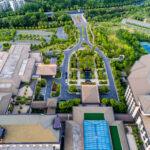The idea of beauty shows up as a potent force that can work in harmony with environmental sustainability in the delicate dance between technological advancement and ecological preservation. Beautification goes beyond aesthetics to support the need to encourage environmentally beneficial behavior. This draft examines the close relationship between environmental sustainability and beautification, including green infrastructure, sustainable design, and conservation initiatives that improve natural environments.
The Green Renaissance: A Redefining of Sustainable Architecture
Introduction
• Outlining the revolutionary potential of sustainable design in enhancing the aesthetics of the environment.
Principles of Sustainable Architecture
• Examine the fundamental ideas of sustainable architecture, such as waste minimization, eco-friendly material utilization, and energy efficiency.
Green building certifications
• Talk about how important it is to promote sustainable building practices by obtaining certifications such as LEED (Leadership in Energy and Environmental Design).
Ecologic Design
• Draw attention to the application of ecologic design concepts, which promote a relationship between constructed settings and the natural world.
Green Infrastructure: Promoting Natural Environments in Urban Areas
Introduction
• The ways in which green infrastructure enhances urban aesthetics and advances environmental sustainability.
Urban Green areas
• Talk about how adding green areas to urban planning can improve biodiversity and aesthetic appeal.
Green Roofs and Walls
• Investigate the use of green walls and roofs in architecture to reduce urban heat islands and create homes for wildlife and vegetation.
Sustainable Urban Drainage Systems (SUDS)
• Emphasize the function of Sustainable Urban Drainage Systems (SUDS) in both storm water management and the enhancement of urban landscapes’ visual appeal
Conservation Activities: Preserving Natural Beauty:
Introduction
• The mutually beneficial link that exists between natural landscape beauty and conservation activities.
Biodiversity Conservation
• Talk about the significance of maintaining biodiversity in natural environments and how it affects aesthetics.
Restoration Ecology
• Examine the concepts of restoration ecology and how they help to improve the aesthetics of ecosystems that have deteriorated.
Community-Led Conservation Initiatives:
• Emphasize the significance of conservation actions sponsored by the community in maintaining the area’s natural assets and scenic areas.
Sustainable Landscape Design: Responsible Creation of Beauty
Introduction
• The ways in which environmentally conscious landscaping techniques enhance the aesthetic appeal of outdoor areas.
Native Plant Landscaping
• Talk about the advantages of adopting native plants in landscaping, such as its ability to promote biodiversity and low care needs.
Ecological Design
• Discover the fundamentals of permaculture design to create regenerative and sustainable landscapes.
Water Conservation in Landscaping
• Emphasize the significance of water-efficient landscaping techniques in order to preserve this valuable resource.
Encouraging Beautification through Environmental Education and Public Awareness Supporters:
Introduction
• The promotion of a community of beautification advocates through environmental education and public awareness.
Involving the Community
• Talk about ways to involve local communities in environmental beautification projects, such as public awareness campaigns and workshops.
Education for Sustainability
• Examine how environmental education might be included into educational institutions to promote a sense of accountability for protecting and beautifying the environment.
Citizen Science
• Draw attention to the ways in which public participation in data gathering and conservation initiatives has an empowering effect.
Crafting Stories of Beauty with Art and Sustainability:
Introduction
• The relationship between sustainability and the arts, and how creative expressions enhance the aesthetic appeal of the natural world.
Environmental Installations
• Talk about the use of art installations to bring attention to environmental problems and turn public areas into representations of environmentally conscious beauty.
Community Murals and Sustainable Messaging
• Explore the ways that street art and community murals may spread messages about environmental sustainability and transform urban environments into living, breathing examples of ecological consciousness.
The Artist’s Role in Conservation
• Showcase artists who, via their artistic endeavors, actively support conservation initiatives and encourage others to do the same.
Sustainable Travel: Encountering Beauty Conscientiously
Introduction
• The ways in which eco-friendly tourist methods can enhance and protect natural environments.
Leave No Trace Principles
• Talk about the significance of the Leave No Trace guidelines in reducing the negative environmental effects of tourism at areas of natural beauty.
Initiatives for Community-Based Tourism
• Emphasize tourist activities driven by the community that put an emphasis on environmental sustainability and enhance the aesthetics of the area.
Educational Tourism
• Investigate the potential of educational tourism initiatives to increase public understanding of the value of protecting and enhancing natural areas.
Corporate Social Responsibility in the Enhancement of the Environment:
Introduction
• The part that corporations play in using sustainable methods to improve the beauty of the environment.
Green Building Certifications for Businesses
• Talk about how businesses are pursuing green building certifications to support environmentally friendly design and architecture.
Initiatives for Corporate Social Responsibility (CSR)
• Emphasize corporate social responsibility programs that enhance the environment, such as tree-planting drives and funding for regional conservation efforts.
Sustainable Supply Chains
• Examine how businesses can improve the environment by implementing ethical and sustainable supply chain procedures.
Assessing Achievement: Environmental Beautification Metrics
Introduction
• Applying relevant measures to assess the effectiveness of environmental beautification projects.
Biodiversity Indices
• Talk about how to use biodiversity indices to assess how well natural landscapes have been preserved and enhanced.
Metrics for Community Engagement
• Examine indicators of community involvement in beautification initiatives, such as the number of volunteers or the effectiveness of public awareness campaigns.
Sustainability Impact Assessment
• Examine the idea of sustainability impact assessment and its application to assessing the long-term environmental effects of beautification projects.
CONCLUSION
• Beautification can lead to a greener future.
• Describe the complex relationship that exists between environmental sustainability and beautification, emphasizing the ways in which eco-friendly methods improve natural settings.
• Stress that it is our shared duty to make environmental beautification a top priority in all facets of human endeavor, from building to conservation.
• End by extending an invitation to the readers to take up the mantle of sustainability and beauty by actively supporting projects that maintain, safeguard, and improve the planet’s ecological fabric.


